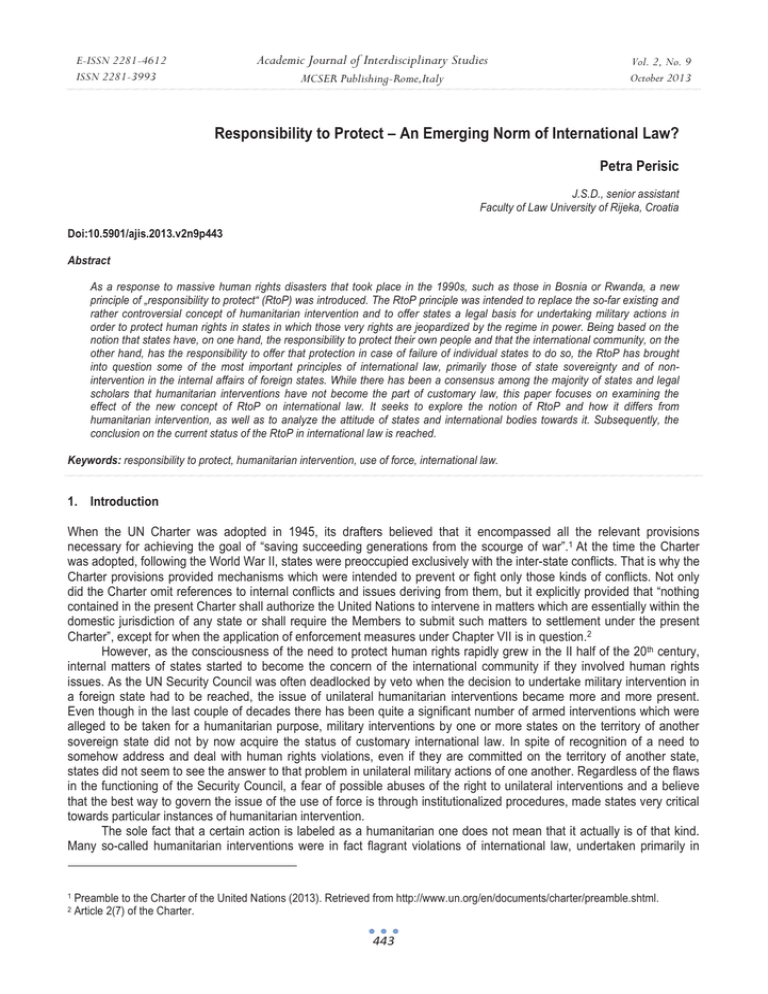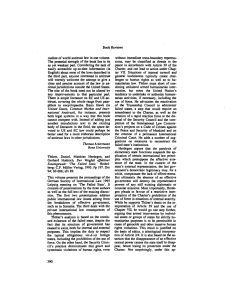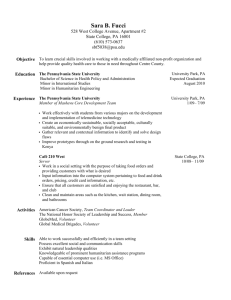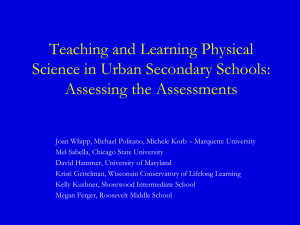Responsibility to Protect – An Emerging Norm of International Law?
advertisement

Academic Journal of Interdisciplinary Studies E-ISSN 2281-4612 ISSN 2281-3993 MCSER Publishing-Rome,Italy Vol. 2, No. 9 October 2013 Responsibility to Protect – An Emerging Norm of International Law? Petra Perisic J.S.D., senior assistant Faculty of Law University of Rijeka, Croatia Doi:10.5901/ajis.2013.v2n9p443 Abstract As a response to massive human rights disasters that took place in the 1990s, such as those in Bosnia or Rwanda, a new principle of „responsibility to protect“ (RtoP) was introduced. The RtoP principle was intended to replace the so-far existing and rather controversial concept of humanitarian intervention and to offer states a legal basis for undertaking military actions in order to protect human rights in states in which those very rights are jeopardized by the regime in power. Being based on the notion that states have, on one hand, the responsibility to protect their own people and that the international community, on the other hand, has the responsibility to offer that protection in case of failure of individual states to do so, the RtoP has brought into question some of the most important principles of international law, primarily those of state sovereignty and of nonintervention in the internal affairs of foreign states. While there has been a consensus among the majority of states and legal scholars that humanitarian interventions have not become the part of customary law, this paper focuses on examining the effect of the new concept of RtoP on international law. It seeks to explore the notion of RtoP and how it differs from humanitarian intervention, as well as to analyze the attitude of states and international bodies towards it. Subsequently, the conclusion on the current status of the RtoP in international law is reached. Keywords: responsibility to protect, humanitarian intervention, use of force, international law. 1. Introduction When the UN Charter was adopted in 1945, its drafters believed that it encompassed all the relevant provisions necessary for achieving the goal of “saving succeeding generations from the scourge of war”.1 At the time the Charter was adopted, following the World War II, states were preoccupied exclusively with the inter-state conflicts. That is why the Charter provisions provided mechanisms which were intended to prevent or fight only those kinds of conflicts. Not only did the Charter omit references to internal conflicts and issues deriving from them, but it explicitly provided that “nothing contained in the present Charter shall authorize the United Nations to intervene in matters which are essentially within the domestic jurisdiction of any state or shall require the Members to submit such matters to settlement under the present Charter”, except for when the application of enforcement measures under Chapter VII is in question.2 However, as the consciousness of the need to protect human rights rapidly grew in the II half of the 20th century, internal matters of states started to become the concern of the international community if they involved human rights issues. As the UN Security Council was often deadlocked by veto when the decision to undertake military intervention in a foreign state had to be reached, the issue of unilateral humanitarian interventions became more and more present. Even though in the last couple of decades there has been quite a significant number of armed interventions which were alleged to be taken for a humanitarian purpose, military interventions by one or more states on the territory of another sovereign state did not by now acquire the status of customary international law. In spite of recognition of a need to somehow address and deal with human rights violations, even if they are committed on the territory of another state, states did not seem to see the answer to that problem in unilateral military actions of one another. Regardless of the flaws in the functioning of the Security Council, a fear of possible abuses of the right to unilateral interventions and a believe that the best way to govern the issue of the use of force is through institutionalized procedures, made states very critical towards particular instances of humanitarian intervention. The sole fact that a certain action is labeled as a humanitarian one does not mean that it actually is of that kind. Many so-called humanitarian interventions were in fact flagrant violations of international law, undertaken primarily in 1 2 Preamble to the Charter of the United Nations (2013). Retrieved from http://www.un.org/en/documents/charter/preamble.shtml. Article 2(7) of the Charter. 443 E-ISSN 2281-4612 ISSN 2281-3993 Academic Journal of Interdisciplinary Studies MCSER Publishing-Rome,Italy Vol. 2, No. 9 October 2013 order to achieve some other goals but humanitarian of the state(s) undertaking in. It is thus not surprising that these actions were condemned by the majority of states. Yet, the fact that abuses of unilateral interventions are possible does not diminish the need to help those being deprived of their rights, even by the use of force if necessary. Following this line of reasoning, the concept of the Responsibility to Protect was born. After the Cold War ended, the beginning of the 90ies was characterized by the temporary euphoria of the formerly warring parties, which reestablished their cooperation. This was particularly seen through the international response in the case of Iraqi invasion of Kuwait in 1991 (Evans, 2001). However, not more than couple of years later, international community inadequately responded to humanitarian disasters of dramatic proportions, such as those in Somalia, Rwanda or Bosnia. The occurrence of these disasters created an impulse in the international community to do something against the repetition of similar scenarios. 2. International Commission on Intervention and State Sovereignty As there was no consensus between those who, like Bernard Kouchner of Médecins Sans Frontieres, argued in favor of the possibility to intervene militarily in a foreign state in order to save human lives, and those who fought for the perseverance of the concept of national sovereignty, seen as a complete inhibitor to any coercive intervention, the UN Secretary General Kofi Annan made a plea to the General Assembly for considering the issue of reconciling the respect for sovereignty on one hand and respect for gross violations of human rights on the other (Evans, 2001). It was in 2001 that the Canadian Prime Minister Jean Chrétien established an independent body, the International Commission on Intervention and State Sovereignty (ICISS), which issued the Report titled “The Responsibility to Protect”, coining this term in the process (Eaton, 2001). Although the very first sentence of the Report announces that “the Report is about the so-called right of humanitarian intervention”,3 it aims at introducing the new concept, trying to distinguish it from the classical notion of humanitarian intervention. The Report is built on two basic principles: first, that state sovereignty implies responsibility, and the primary responsibility for the protection of its people lies with the state itself, and second, where a population is suffering serious harm, as a result of internal war, insurgency, repression or state failure, and the state in question is unwilling or unable to halt or avert it, the principle of non-intervention yields to the international responsibility to protect.4 It was thus the intention of the Report to emphasize that state sovereignty implies responsibility and not a license to kill.5 The concept of responsibility to protect, as presented in the ICISS Report, is broader than the one of humanitarian intervention, insomuch as it does not comprise solely the right of states to conduct military intervention, but also their responsibilities prior and post the conflict. The Report thus envisioned three main responsibilities of states: the responsibility to prevent, the responsibility to react and the responsibility to rebuild. Prevention of conflicts is seen primarily as the responsibility of sovereign states and the communities and institutions within them, which have to put an effort in ensuring accountability and good governance, protection of human rights, promotion of social and economic development and ensuring a fair distribution of resources.6 However, the conflict prevention is not merely a national or local affair, because the failure of prevention can have international consequences and costs. Quite often, the prevention will be impossible without the strong support coming from the international community, which may come in many different forms, such as good offices missions, mediation efforts, efforts to help address the root cause of potential conflict, etc.7 The Report provides for three essential conditions for the effective prevention of conflicts: first, there has to be knowledge of the fragility of the situation and the risks associated with it (the so-called early warning); second, there has to be understanding of the policy measures available that are capable of making a difference (the so-called preventive toolbox); and third, there has to be a willingness to apply those measures (the issue of political will).8 The Responsibility to Protect, Report of the International Commission on Intervention and State Sovereignty (2013). Retrieved from http://responsibilitytoprotect.org/ICISS%20Report.pdf (hereinafter “the Report”). 4 Synopsis of the Report, supra note 3. 5 The Responsibility to Protect (R2P): A primer (2013). Retrieved from http://www.crisisgroup.org/en/publication-type/commentary/evansstate-sovereignty-was-a-licence-to-kill.aspx. 6 The Report, para. 3.2. 7 Ibid., para. 3.3. 8 Ibid., para. 3.9. 3 444 E-ISSN 2281-4612 ISSN 2281-3993 Academic Journal of Interdisciplinary Studies MCSER Publishing-Rome,Italy Vol. 2, No. 9 October 2013 When preventive measures fail to resolve the situation and when a state is unable or unwilling to redress the situation, then intervention measures by other members of the broader community of states may be required. The Report recommends undertaking of non-military measures, such as political, economic or judicial measures, if possible. Only in extreme cases should states include military action.9 Naturally, the question of which cases should be characterized as urgent arose. The Report emphasizes the respect for the non-intervention principle, however it finds that there are situations in which the interest that all states have in maintaining the stable international order requires them to react when all order within the state has broken down or when civil conflict and repression are so violent that civilians are threatened with massacre, genocide or ethnic cleansing on a large scale. 10 There are six criteria necessary for undertaking military intervention set down in the Report: right authority, in sense of possible holders of the right to military intervention,11 just cause (if intervention is being conducted in order to halt or avert large scale loss of life, actual or apprehended, with genocidal intent or not, which is the product either of deliberate state action, or state neglect or inability to act, or a failed state situation; or to halt or avert large scale “ethnic cleansing”, actual or apprehended, whether carried out by killing, forced expulsion, acts of terror or rape), right intention (the primary purpose of the interventions must be to halt or avert human suffering, and not to, for example, alter the borders, advance a particular combatant group’s claim to self-defense, etc), last resort (military action is allowed if all other non-military means have been explored, although not each of these means must literally have been tried and failed), proportional means (scale, duration and intensity of the planned military intervention should be the minimum necessary to secure the humanitarian objective in question), and reasonable prospects (military action can only be justified if it stands a reasonable chance of success).12 Finally, the Report elaborates the states’ responsibility to rebuild, which comes into play after the military action has been undertaken. Intervening state(s) should be dedicated to helping the state in which the intervention took place to build a durable peace, establish good governance and sustainable development, which may sometimes require a prolonged presence of the former in the latter. 13 Providing basic security in that state, including protection for all its members, resolving issues of disarmament, demobilization and reintegration, restoring judicial systems, regulating the return and legal rights of refugees are only some of the tasks that should be done during the process of rebuilding.14 The ICISS points out three key advantages of this new concept: first, the shift of focus from the state that holds the right to those in need of protection; second, it emphasizes the primary responsibility of the state whose nationals are in need of help; and finally, it broadens the concept of humanitarian intervention to the all-encompassing management of a humanitarian crisis (Eckert, 2012). The Report aimed at reconciling the protection of human rights and respect for the state sovereignty, establishing thus a new concept of sovereignty – a concept in which sovereignty is seen as a responsibility of state, rather than its right. Yet, one particular feature of the Report, which arguably represents the core issue of the entire RtoP concept, remained ambiguous. This issue deals with the holders of the right to intervene by military force in order to halt human rights disasters. The Report reiterates the UN Charter provisions regulating the use of force and points out that only two exceptions to the general ban on the use of force – self-defence and the collective action authorized by the Security Council – are provided by the Charter. 15 Since no “humanitarian exception” to the prohibition of force is explicitly provided, the Report points to the paramount importance of the Security Council in resolving humanitarian crisis.16 Even though the Report elaborates on why the Security Council should be given primacy in authorizing the use of force in situations of gross violations of human rights by a regime of a certain country, the Report rightfully reminds of a fact that there are situations in which the Security Council is either unable or unwilling to act. It therefore poses a question of what should be done in such situations. Two alternatives to the Security Council have been presented: one is seeking the support for military action from the General Assembly, under the established Uniting for Peace procedures,17 and another would be pursuing collective Ibid., para. 4.1. Ibid., para. 4.13. 11 See infra, text by the notes 15-21. 12 The Report, paras. 4.16-4.41. 13 Ibid., paras. 5.1-5.2. 14 See: paras. 5.8-5.15. 15 See Articles 2(4), 51 and 42 of the Charter. 16 The Report, para. 6.13. 17 GA Res. 377 (V). 9 10 445 E-ISSN 2281-4612 ISSN 2281-3993 Academic Journal of Interdisciplinary Studies MCSER Publishing-Rome,Italy Vol. 2, No. 9 October 2013 intervention by a regional or sub-regional organization acting within its own boundaries.18 There is, though, a problem with each of these two alternatives: the General Assembly decisions do not have a binding force upon states, so the resolution adopted on an Emergency Special Session can only serve as a recommendation, and regional organizations should not, according to the Charter, conduct military actions in the absence of the Security Council authorization. In spite of all this, the Report suggests that both military actions undertaken pursuant to General Assembly resolutions and those undertaken by regional organizations might posses the necessary legitimacy.19 Finally, the Report elaborates the possibility of individual states or groups of states in exercising the responsibility to protect by employing military force. This represents the crucial issue of the RtoP doctrine – practically all states can agree on the need to protect human rights, but it is much more difficult to reach a consensus on the possibility of undertaking unilateral military interventions. What is actually the conclusion of the Report in this respect is not quite clear. It is not maintained that individual states or groups of states are entitled to conduct military operations, but the Report says that “it is unrealistic to expect that concerned states will rule out other means and forms of action to meet the gravity and urgency of these situations” “if the Security Council fails to discharge its responsibility in conscience-shocking situations crying out for action”.20 Introduction of the practice of undertaking unilateral interventions would on one hand lead to situations in which they would, without the discipline and constraints of the UN authorization, not be conducted for the right reasons, and on the other hand, should they turn out to be successful and supported by the international community, lead to undermining the credibility of the UN and its purpose. 21 What stands behind these words of the Report is open to interpretations. Was it a gateway towards justifying unilateral actions conducted under the RtoP mantra, or was it just a realistic observation of the state practice, which shows that states tend to conduct unilateral humanitarian interventions in situations they claim that such actions are necessary, regardless of whether they have obtained the Security Council authorization or not? Although the ICISS quite enthusiastically coined this new and somewhat altered variation of humanitarian intervention, it seems that states were not comfortable to go so far just yet. As will be seen from the analysis of other international documents embracing the RtoP concept, it appears that consensus could only have been reached with regard to accepting the general idea of the need to protect human rights in states with oppressive regimes. But many other questions, such as those concerning the holders of the right to intervene, or those establishing the exact content of the RtoP, have remained open. 3. Responsibility to Protect within the UN system 3.1 The UN High-Level Panel on Threats, Challenges and Change: A More Secure World, Our Shared Responsibility After the adoption of the ICISS Report, the first time the RtoP principle was discussed within the UN was in the Report of the Secretary-General’s High Level Panel on threats, Challenges and Change. In a way criticizing the UN Charter for declaratory “reaffirming faith in fundamental human rights”, but doing very little to protect them, as well as criticizing the Security Council for being “inconsistent” and “ineffective” in dealing with humanitarian catastrophes, 22 the High-Level Panel saw the idea of responsibility to protect as a means to strengthen the collective security system under the Charter (Stahn, 2007). Similar to the ICISS Report, this Report confirmed the responsibility to protect principle and reiterated both the obligation of each state to protect its own citizens from humanitarian catastrophes, as well as the responsibility of a wider international community when these particular states are unable or unwilling to do so. The Report makes a distinction between the “right to intervene” and the “responsibility to protect”, the latter being the obligation of every state when it comes to people suffering from avoidable catastrophe – mass murder and rape, ethnic cleansing by forcible expulsion and terror, and deliberate starvation and exposure to disease.23 The reference to the responsibility of “every state” left room for different interpretations – it could, on one hand, be interpreted as a reminder of the erga omnes Chapter VIII of the Charter. The Report, paras. 6.29-6.35. 20 Ibid., para. 6.39. 21 Ibid., para. 6.40. 22 A More Secure World: Our Shared Responsibility, Report of the Secretary General's High-Level Panel on Threats, Challenges and Change (2013), para. 199, 202. Retrieved from http://www.un.org/secureworld/ (hereinafter “High-level Panel Report”). 23 High-level Panel Report, para. 201. 18 19 446 E-ISSN 2281-4612 ISSN 2281-3993 Academic Journal of Interdisciplinary Studies MCSER Publishing-Rome,Italy Vol. 2, No. 9 October 2013 obligation of states to protect human rights, and on the other, it might have a broader meaning, under which the responsibility of the host state shifts to every other state when the former is unwilling or unable to act (Stahn, 2007). An important difference of the High-Level Panel Report in comparison with the one of the ICISS is that it does not provide for any alternatives to the Security Council when it comes to conducting military operations. Instead, it emphasizes the need to strengthen the role of the Security Council. In essence, the High-Level Report brings nothing new by embracing the RtoP concept. It merely confirms an already existing authority of the Security Council to act pursuant to Chapter VII of the UN Charter and authorize states to use force if precondition from Article 39 of the Charter – the existence of threat to peace, breach of the peace and act of aggression – has been fulfilled. However, although there are no novelties in the legal sphere, the significance of the Report nevertheless lies in its attempt to strengthen the responsibility of the Security Council. A primary role in matters concerning international peace and security, which was given by states to the Security Council,24 should not be interpreted as its privilege, which can be disposed of at will, but rather an important responsibility towards an international community and towards each state as its integral part. This particularly refers to the possible misuse of the veto power by the permanent members of the Security Council, as well as the failure to act out of political reasons. 3.2 The Secretary-General, In Larger Freedom: Towards Development, Security and Human Rights for All Secretary-General Annan endorsed the concept of RtoP, emphasizing thought that he was “well aware of the sensitivities involved in this issue”. 25 Like the ICISS and the High-Level Panel, he embraced the responsibility to protect as a responsibility which lies, first and foremost, with each individual state, whose primary raison d’etre is to protect its population. But if national authorities are unable or unwilling to protect their citizens, then the responsibility shifts to the international community to use diplomatic, humanitarian and other methods to help protect the human rights and wellbeing of civilian populations. 26 The Secretary-General thus puts an emphasis on non-forcible means of saving the population in danger. However, if such means should prove to be insufficient, Security Council may out of necessity decide to take action under the Charter of the United Nations, including enforcement action.27 Like the High-Level Panel, but unlike the ICISS, the Secretary-General Report proposes no alternatives to the Security Council. By doing so, it merely confirms the Security Council Chapter VII powers, but at the same time, by outlining the need to act on the RtoP if necessary, tries to strengthen the sense of responsibility of the Security Council in responding to human rights catastrophes. In the Secretary-General Report the concept of RtoP was removed from the section on the use of force and placed in the section dealing with freedom to live in dignity, so as to detach the idea of responsibility from an automatic equation to armed force, presenting thus the RtoP not as a surrogate for humanitarian intervention but as a strategy to promote the commitment of all nations to the rule of law and human security (Stahn, 2007). 3.3 2005 World Summit Outcome Document The World Summit Outcome Document is probably the most authoritative document dealing with the issue of RtoP, as it represents the attitude of more than 190 states participating on the Summit. The text of the Document reflects a lack of consensus among states when it comes to determining the specific content of the responsibility to protect, as well as who is authorized to use force if that should be found necessary. As in previous documents, the Document envisages firstly the responsibility of each individual state to protect its populations from genocide, war crimes, ethnic cleansing and crimes against humanity. Alternatively, there is a responsibility of the international community as a whole to, on one hand, encourage and help states to exercise that responsibility, and, on the other, to act itself if national authorities manifestly fail to protect their populations from genocide, war crimes, ethnic cleansing and crimes against humanity.28 Article 24 of the UN Charter. In Larger Freedom: towards Development, Security and Human Rights for all, Report of the Secretary-General (2013). Retrieved from http://www.un.org/largerfreedom/. 26 Ibid., para. 135. 27 Loc. cit. 28 The 2005 World Summit Outcome Document (2013). Retrieved from http://daccess-dds-ny.un.org/doc/UNDOC/GEN/N05/487 /60/PDF/N0548760.pdf?OpenElement. 24 25 447 E-ISSN 2281-4612 ISSN 2281-3993 Academic Journal of Interdisciplinary Studies MCSER Publishing-Rome,Italy Vol. 2, No. 9 October 2013 The emphasis in achieving these goals is put on the peaceful means, such as diplomatic and humanitarian means, which have to be used in accordance with the UN Charter. States also commit themselves to taking collective action, but through the Security Council and in accordance with the Charter, including Chapter VII. Thus, the Document again proves the respect of states for the institutionalized procedures within the United Nations and leaves no room for interpretation that individual states might conduct unilateral military interventions, even those based on humanitarian grounds. It could not be concluded from the Outcome Document that states are willing to accept the RtoP as anything more than a moral responsibility. As the US ambassador stated prior to the World Summit, the US “would not accept that either the United Nation as a whole, or the Security Council, or individual states, have an obligation to intervene under international law”.29 Other states too – Argentina, Brazil, China, the Phillipines and Russia – cautioned against support for the responsibility to protect (Mohamed, 2012). The legal obligation of states to use force remained only in cases in which the Security Council would, based on the determination of the existence of the threat to peace, breach of the peace or act of aggression in accordance with Article 39, order military action of the UN member states. As states had divergent views on the RtoP, in the Outcome Document they stressed the need for the General Assembly to continue consideration of the responsibility to protect populations from genocide, war crimes, ethnic cleansing and crimes against humanity. 3.4 Secretary-General Ban Ki-moon Reports on RtoP Continuing the process of discussing the RtoP principle, Secretary-General Ban Ki-moon issued four reports on this matter: the 2009 Report – Implementing the Responsibility to Protect; The 2010 Report – Early Warning, Assessment, and the Responsibility to Protect, the 2011 Report – the Role of Regional and Sub-regional arrangements in Implementing the Responsibility to Protect, and the 2012 Report – Responsibility to Protect – Timely and Decisive Action. Secretary-General interpreted the Summit Outcome Document as suggesting three pillars of the responsibility to protect: - first pillar encompasses the enduring responsibility of the state to protect its populations from genocide, war crimes, ethnic cleansing and crimes against humanity; - second pillar is the commitment of the international community to assist states in meeting those obligations; - third pillar is the responsibility of member states to respond collectively in a timely and decisive manner when a state is manifestly failing to provide such protection.30 Special attention has been paid to the responsibility of the permanent members of the Security Council, who “bear particular responsibility because of the privileges of tenure and the veto power they have been granted under the Charter”.31 Secretary-General urges them to refrain from employing or threatening to employ the veto in situations of manifest failure to meet obligations relating to the responsibility to protect, as defined in the Summit Outcome Document, and to reach a mutual understanding to that effect. Secretary-General Reports elaborate different issues related to the RtoP principle: the possibility of its implementation, the need for its further development, the inclusion of regional and sub-regional arrangements in its implementation. In his last Report from 2012, the Secretary-General did not depart from his conclusion presented in the 2009 one, according to which the responsibility to protect must conform to the UN Charter, meaning that it does not alter the existing responsibility of the UN Member States to abstain from using force, unless the use of force is legal under the UN Charter.32 The 2012 Report elaborates the possibility of implementing the RtoP by using measures provided by Chapter VI and VIII of the Charter, whereas forcible measures under Chapter VII can only be employed as a last resort.33 Again, there is no mention of the right of individual states to use force outside of the United Nations umbrella, that is, without the authorization of the Security Council. The Letter of the Representative of the United States of America to the United Nations (2013). Retrieved from http://responsibilitytoprotect.org/files/US_Boltonletter_R2P_30Aug05%5B1%5D.pdf. 30 Implementing the Responsibility to Protect, Report of the Secretary-General (2013), paras. 11-12. Retrieved from http://www.unrol.org/ files/SG_reportA_63_677_en.pdf. 31 Ibid., para. 61. 32 Ibid., para. 67. 33 Responsibility to Protect: Timely and Decisive Response, (2013). Retrieved from http://www.responsibilitytoprotect.org/UNSG %20Report_timely%20and%20decisive%20response(1).pdf. 29 448 E-ISSN 2281-4612 ISSN 2281-3993 Academic Journal of Interdisciplinary Studies MCSER Publishing-Rome,Italy Vol. 2, No. 9 October 2013 The responsibility to protect has undergone a series of debates and discussions in the UN system, with no real consensus emerging on the propriety of the principle, except that it should remain a principle and not be codified as any binding legal obligation (Mohamed, 2012). 4. Conclusion – what is the current status of the RtoP? The inclusion of the RtoP principle in the UN documents shows that it has progressed from the mere idea, expressed in the ICISS Report, towards a possibly emerging norm of international law. Such a development is by some an achievement of the RtoP in itself (Badescu, 2001). Both UN Secretaries-General, Kofi Annan and Ban Ki-moon, have dedicated themselves strongly to promoting the principle. What adds a particular weight to the principle is its inclusion in the resolutions of General Assembly and even more of the Security Council. The first Security Council resolution which endorsed the RtoP concept was resolution 1674 on the protection of the civilians. 34 It reaffirmed the relevant provisions from the World Summit Outcome Document regarding the responsibility to protect populations from genocide, war crimes, ethnic cleansing and crimes against humanity. This resolution was followed by another one, 1706, which made the same referral to the RtoP principle from the World Summit Outcome Document.35 The resolution, which demanded the deployment of peacekeeping forces in Darfur, was adopted under Chapter VII of the UN Charter, as well as another one addressing the Darfur crisis.36 The Security Council continued to invoke the RtoP in its subsequent resolutions adopter under Chapter VII – in resolution 1973 concerning the situation in Libya,37 and in resolution 1975 concerning the post-electoral crisis in Côte d’Ivoire.38 Some believe that the invocation of the RtoP in the Security Council resolutions adopted under Chapter VII point to the conclusion that the Security Council, and indirectly the international community as a whole, believe in the legally binding nature of that principle (Matthews, 2008; Nanda, 2006 – 2007). Such contentions are further supported by the fact that the General Assembly, as a universal forum, endorsed the RtoP in its resolution.39 The most authoritative document on RtoP is the World Summit Outcome Document, as it represents a standpoint of a large number of states. The Document employed an ambiguous language in describing the content of RtoP. What, however, is certain, from the text of the Document is that states were not willing to either oblige themselves to act in cases of mass violations of human rights, continuing to understand RtoP more as their right than their obligation, as well as that they were not ready to authorize anyone but the Security Council to decide on these issues. It is possible that RtoP evolves into a hard law obligation, however for the time being it is hard to imagine how the RtoP could overcome controversies which were inherent in the phenomenon of humanitarian intervention. In order for RtoP to become a binding legal norm, it first has to be established what the concept of RtoP actually stands for. Should it be determined that it encompasses exclusively, or among other things, the use of military force, the crucial question remains – who is authorized to decide on the use of force. All the relevant bodies so far agreed that this should be the task of the Security Council. As the Secretary-General himself stated, “the task is not to find alternatives to the Security Council, but to make it work better”. Enhancing the effectiveness of the Security Council, and even the not-so-new idea of reforming the Security Council, might be issues to be dealt with. At this point, however, the question of what should be done in case of failure of the Security Council to properly respond to gross violations of human rights in a certain state, as is currently the case with the situation in Syria, remains. Failing to resolve this crucial issue, the RtoP concept has not gone much further than the one of the contentious humanitarian intervention. At this stage, one thing is sure – no new norm of RtoP has been created so far. It is for the future practice of states, accompanied by the opinio juris, to show whether the creation of a new norm of international law will occur. References Badescu, G. C. (2001). Humanitarian Intervention and the Responsibility to Protect, Security and Human Rights, Routledge, London, New York, p. 106. SC Res. 1674 (2006). See also: SC Res. 1894 (2009). SC Res. 1706 (2006). 36 SC Res. 1769 (2007). 37 SC Res. 1973 (2011). 38 SC Res. 1975 (2001). 39 GA Res. 63/308. 34 35 449 E-ISSN 2281-4612 ISSN 2281-3993 Academic Journal of Interdisciplinary Studies MCSER Publishing-Rome,Italy Vol. 2, No. 9 October 2013 Eaton, J. (2001). An Emerging Norm? Determining the Meaning and Legal Status of the Responsibility to Protect, Michigan Journal of International Law, vol. 32, p. 768. Eckert, A. E. (2012). The Responsibility to Protect in the Anarchical Society: Power, Interest, and the Protection of Civilians in Libya and Syria, Denver Journal of International Law and Policy, vol. 41, p. 91. Evans, G. (2006). From Humanitarian Intervention to the Responsibility to Protect, Wisconsin International Law Journal, vol. 24, nr. 3, p. 706. Matthews, M. W. (2008). Tracking the Emergence of a New International Norm: The Responsibility to Protect and the Crisis in Darfur, Boston College International and Comparative Law Review, vol. 31, nr. 1, p. 148 Nanda, V. P. (2006 – 2007). The Protection of Human Rights Under International Law: Will the UN Human Rights Council and the Emerging New Norm „Responsibility to Protect“ Make a Difference?, Denver Journal of International Law and Policy, vol. 35, nr. 3 – 4, p. 353. Stahn, C. (2007). Responsibility to Protect: Political Rhetoric or Emerging Legal Norm?, American Journal of International Law, vol. 101, nr. 1, p. 105. 450






